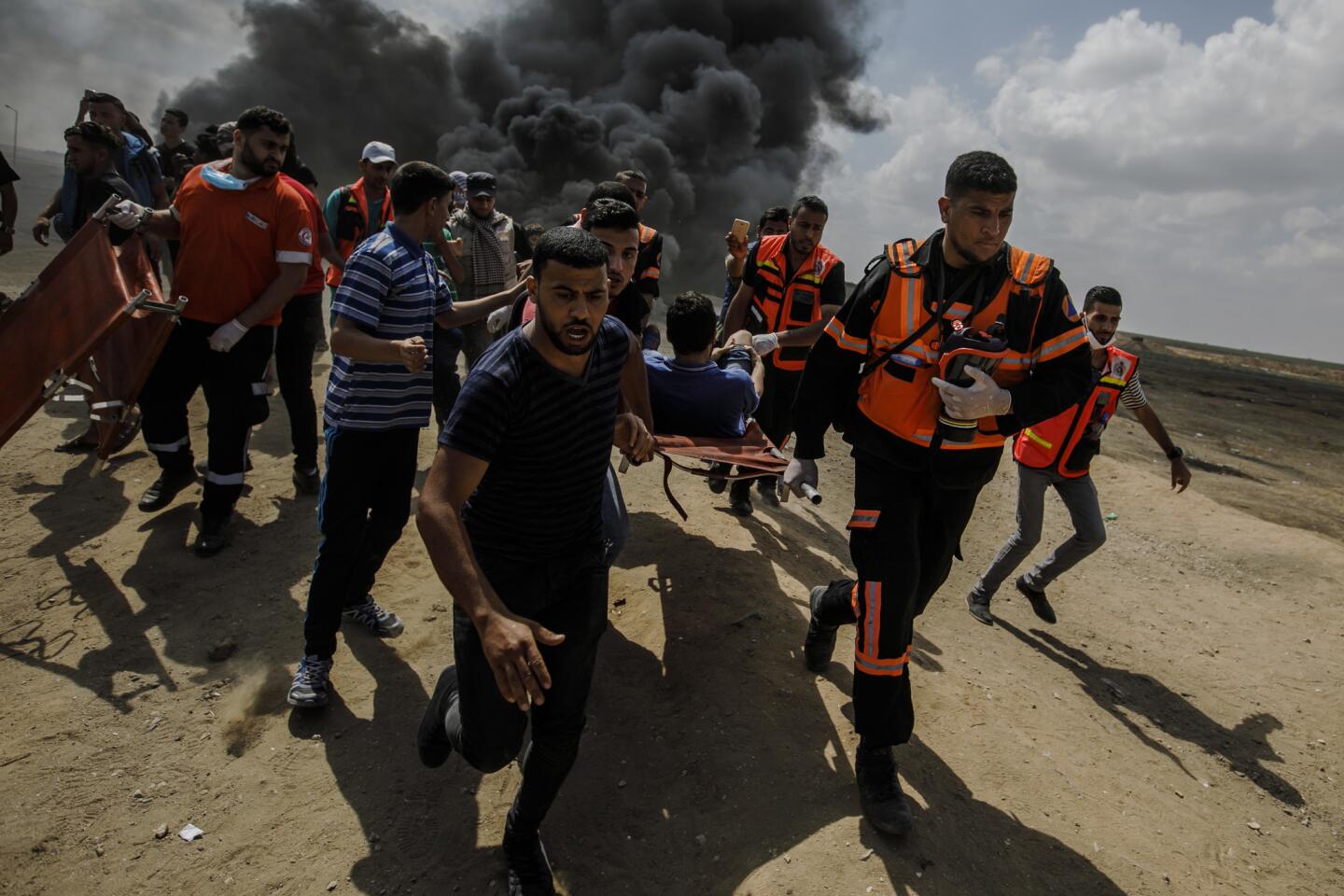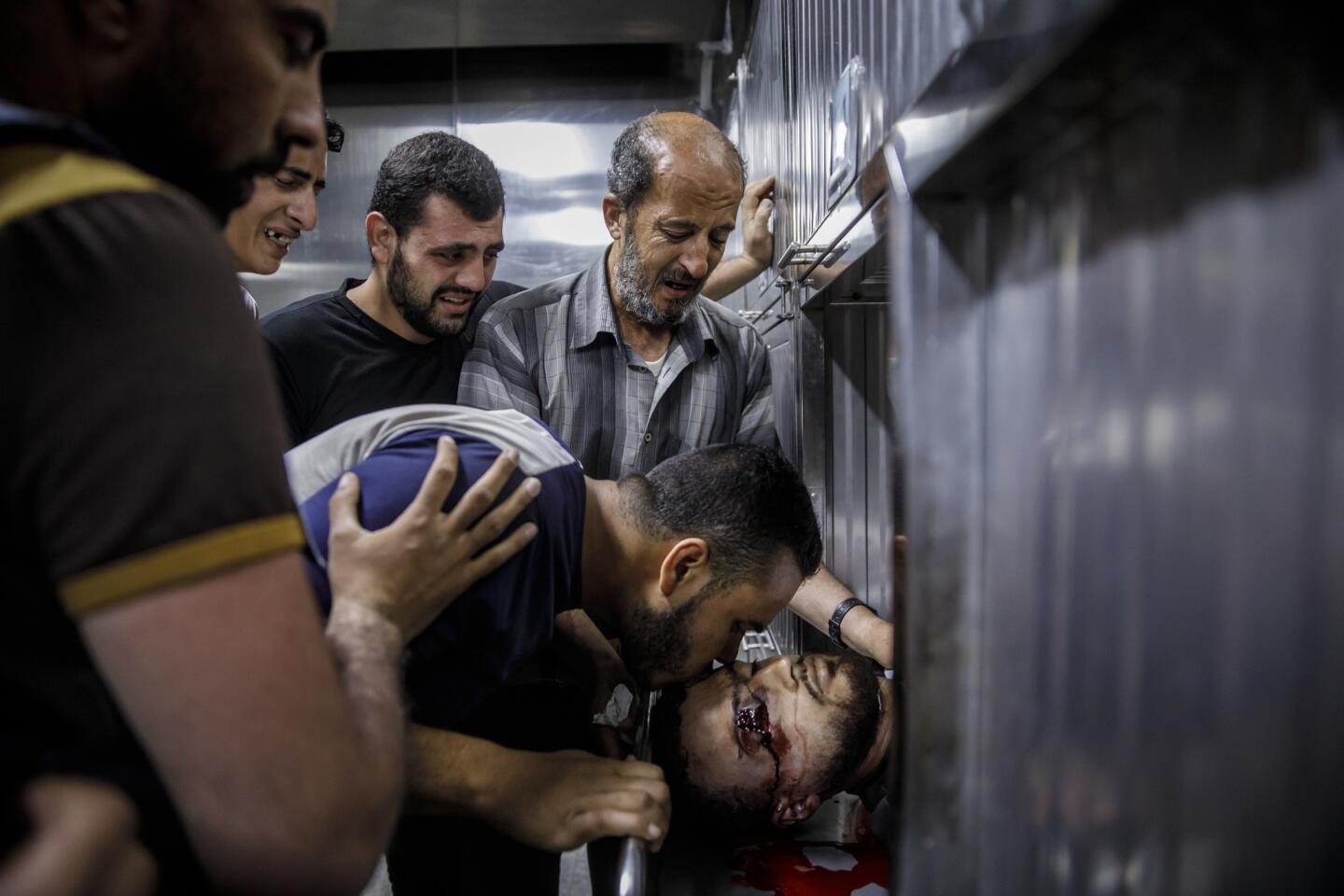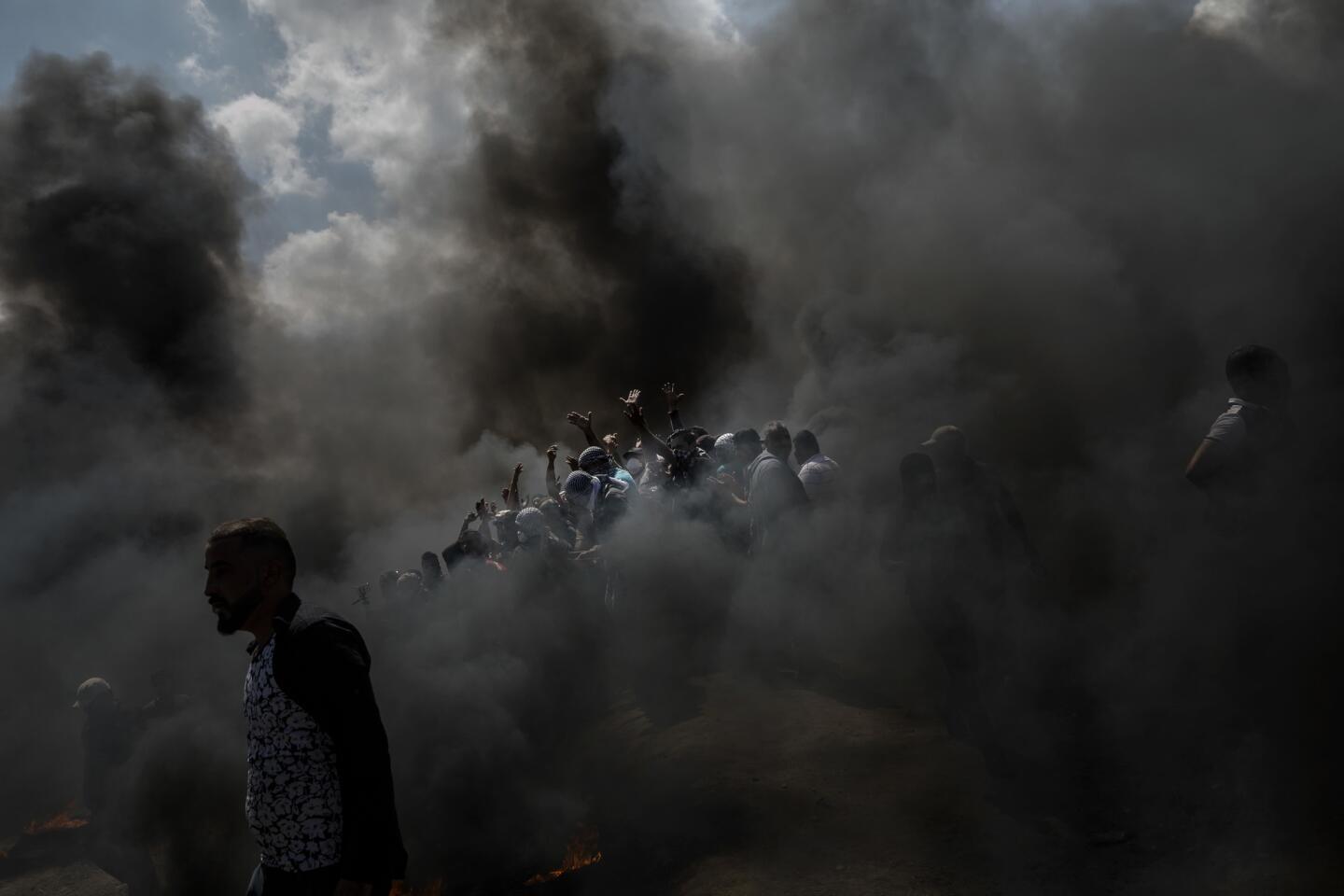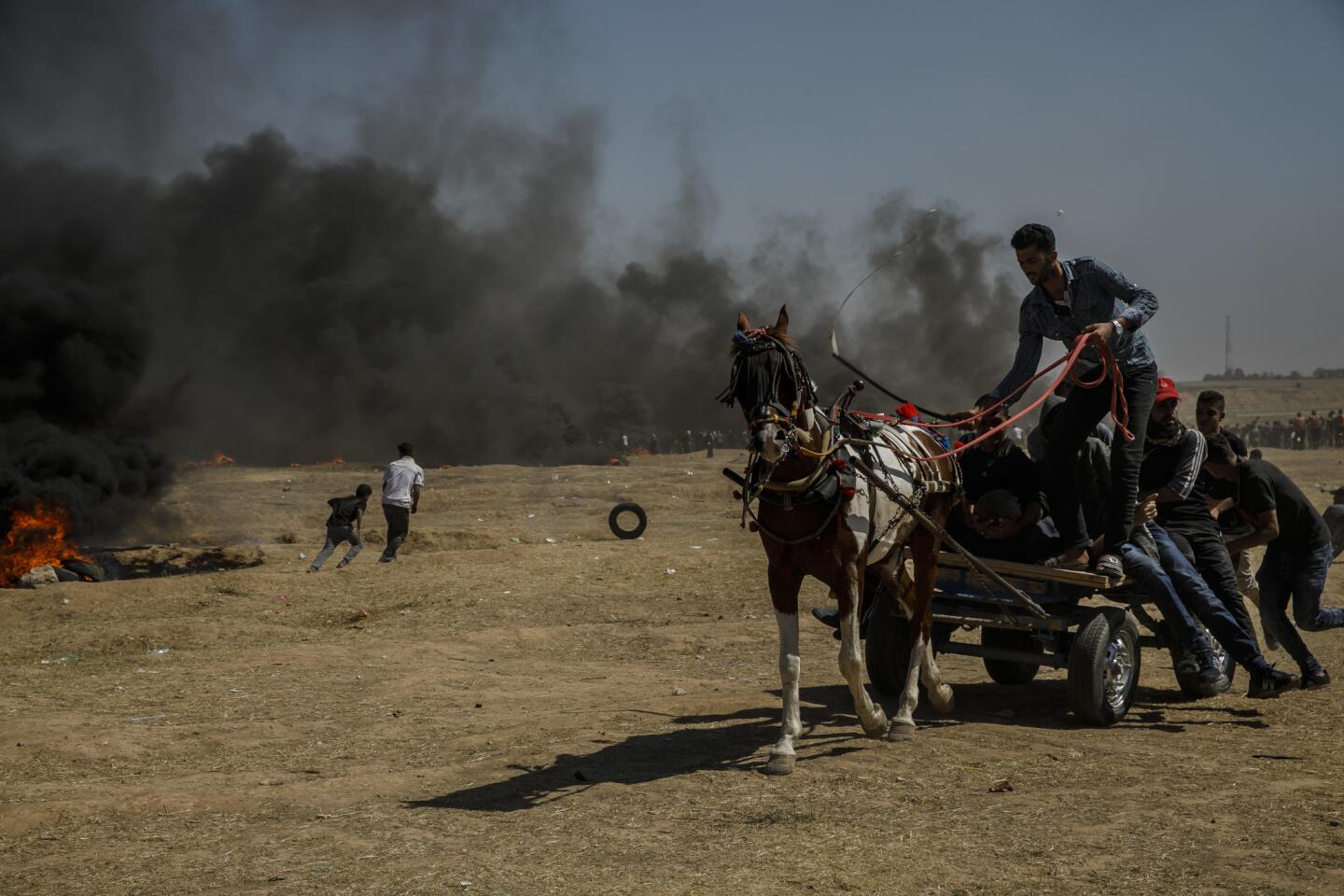Celebration in Jerusalem as U.S. moves embassy, bloodshed in Gaza as dozens of Palestinians killed
- Share via
Reporting from Gaza City — Vivid split-screen realities played out Monday in Jerusalem and the Gaza Strip as the Trump administration brought to symbolic fruition its controversial decision to move the U.S. Embassy to the holy city, while dozens died in a chaotic confrontation between Israeli troops and Palestinians seeking to breach the squalid enclave’s frontier.
The embassy inauguration, presided over by dignitaries who included President Trump’s daughter Ivanka Trump and son-in-law and Mideast advisor Jared Kushner, drew wide condemnation from across the Arab world, and was shunned by U.S. allies in western Europe. The festivities posed an arresting contrast to the bloodshed only 50 miles to the southwest, where at least 55 Palestinians died on the most violent day in weeks of clashes between Gaza protesters and Israeli forces.
Six children were among the dead and more than 2,700 people were injured, according to Palestinian officials. Israel insisted it acted in self-defense and braced for clashes that security officials fear will spread to the West Bank.
With Israeli warplanes roaring overhead in tribute, the American ambassador to Israel, David Friedman, declared that the embassy’s move to contested Jerusalem was a decisive U.S. endorsement of “the right we extend to every other nation — the right to designate its capital city.”
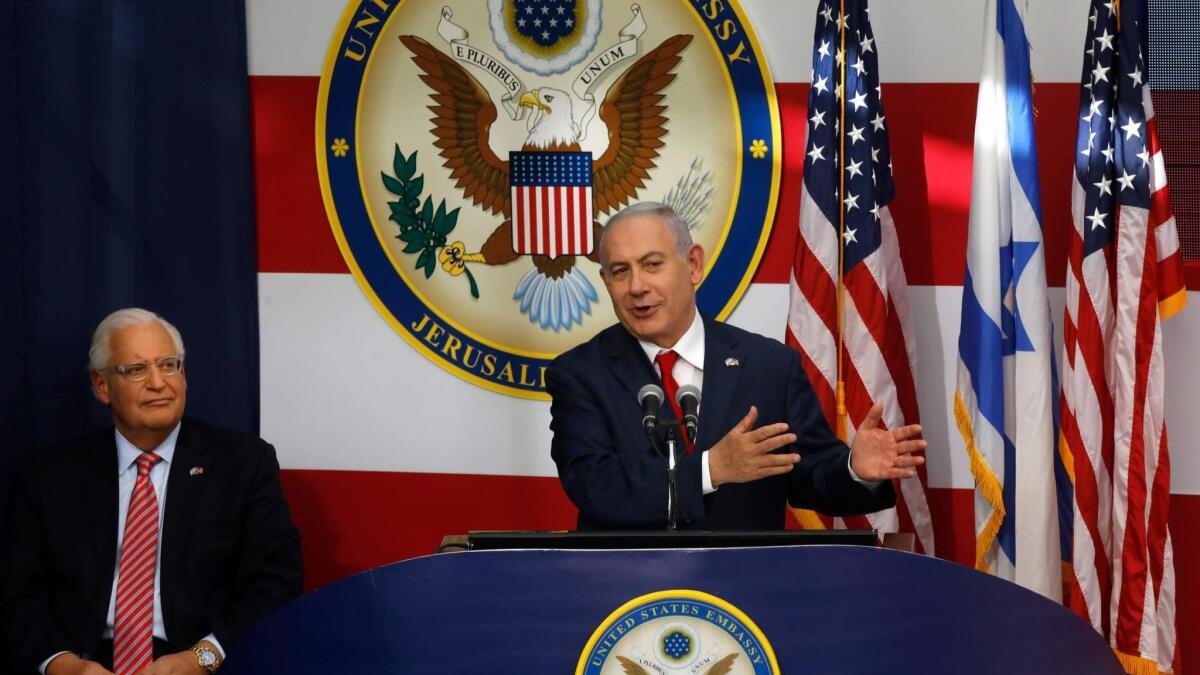
Israeli Prime Minister Benjamin Netanyahu, a key Trump ally who has hailed U.S. moves such as the pullout from the Iranian nuclear deal, praised the U.S. president for “having the courage to keep our promises.” The embassy move was a long-standing Trump pledge, dating back to campaign days.
“What a glorious day for Israel!” said Netanyahu. “We are in Jerusalem, and we are here to stay.”
On the Gaza frontier, flaming tires set alight by protesters sent columns of black smoke aloft as demonstrators fled Israeli fire, some of it from tanks. Israel said protesters hurled firebombs and stones as they tried to break through the border fence, and that its troops came under fire, although no fatalities were reported on the Israeli side.
In a video message played at the embassy celebrations, Trump shrugged off qualms about the American ability to serve as an honest broker in any future Mideast peace talks, declaring that the United States remains committed to “facilitating a lasting peace agreement” between Israel and the Palestinians.
“A great day for Israel!” Trump exulted earlier Monday on Twitter.
At the Jerusalem ceremony, Kushner sought to place blame for the day’s violence — and unrest preceding the embassy inauguration — on Palestinian protesters.
“Those provoking violence are part of the problem, and not part of the solution,” he said.
The U.S. delegation also included four GOP senators and Trump’s Treasury secretary, Steven T. Mnuchin.
The embassy’s formal but temporary move from a sprawling fortified bunker in Tel Aviv to an existing consulate facility in Jerusalem is in many ways symbolic. No decision has been made on a permanent location for the main American diplomatic mission.
The protests in Gaza, ruled by the militant group Hamas, were intended to mark the climax of a weeks-long bid to protest the 70th anniversary of Israel’s creation and the mass Palestinian displacement that accompanied it.
Palestinians had been protesting at the Gaza border since March 30, demanding the right to reclaim ancestral homes in Israel and an end to the stifling blockade imposed on the strip when Hamas took over in 2007. Netanyahu’s government, and preceding Israeli administrations, have deemed the “right of return” a non-starter.
Palestinian health officials said nearly half of the injuries were caused by live ammunition, a higher toll than on previous days. Other people were hit by rubber bullets and shrapnel or were overwhelmed by tear gas.

The day’s jarring juxtapositions — VIP guests and celebratory applause at the Jerusalem ceremony, while sirens wailed and clouds of acrid smoke hung over Gaza — pointed to the latest instance of U.S. isolation even from some of its closest allies. The international consensus has long held that Jerusalem’s fate should be decided through negotiations. Israel claims Jerusalem in its entirety; Palestinians want the city’s eastern sector as the capital of an eventual state.
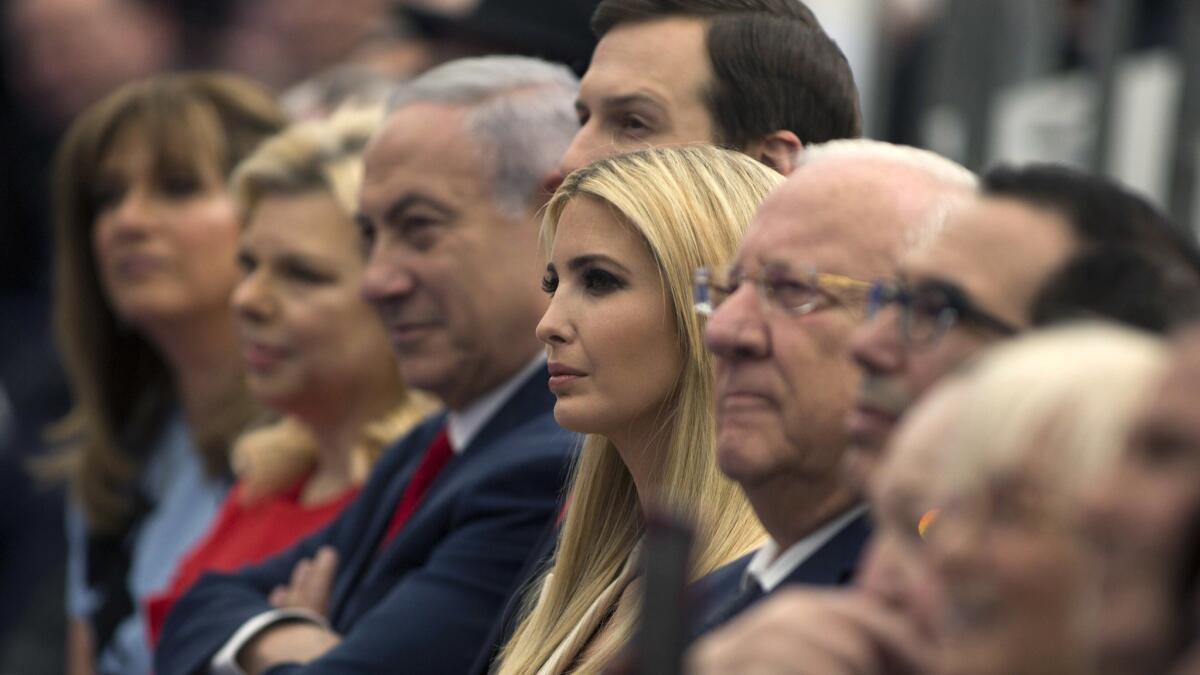
The White House said Hamas bore responsibility for the Gaza casualties, which represented the worst violence since a 2014 war in the enclave. White House spokesman Raj Shah, echoing the position of the Netanyahu government, said Israel “has the right to defend itself.”
But elsewhere, the heavy toll drew expressions of alarm. Federica Mogherini, the European Union’s top diplomat, cited the heavy toll in calling for “utmost restraint to avoid further loss of life.” France called for only “strictly proportionate” use of force by Israel. South Africa recalled its ambassador for consultations, and Kuwait called for an emergency session of the U.N. Security Council.
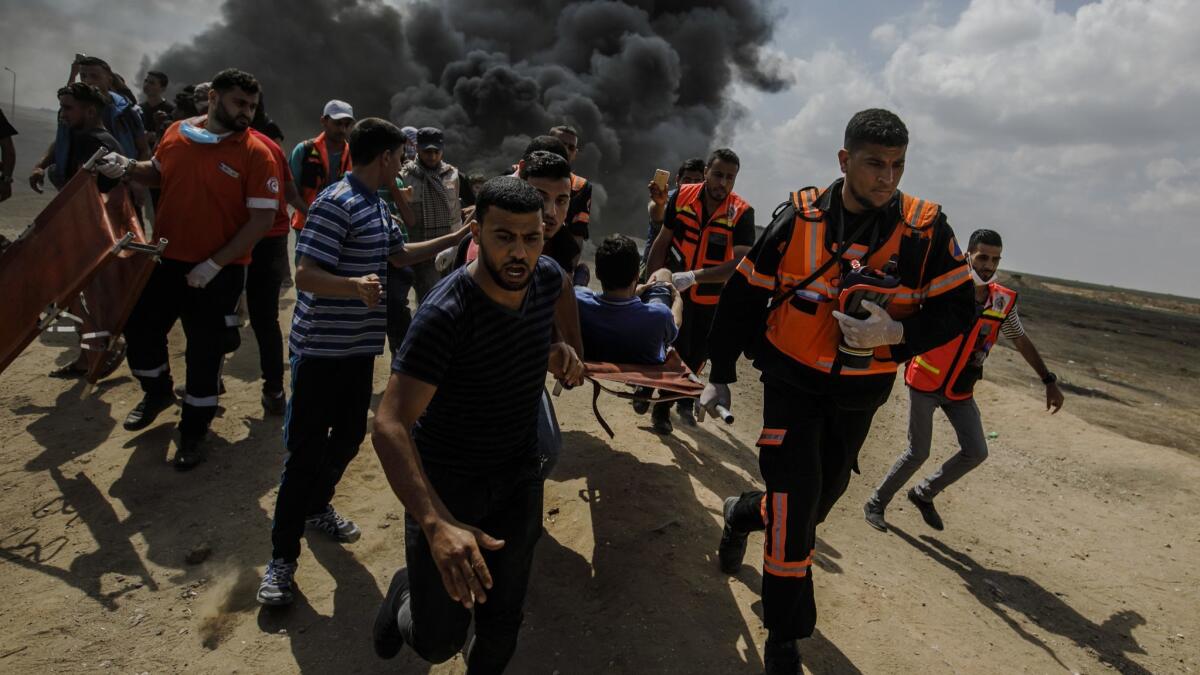
Human rights groups for weeks have denounced Israeli use of lethal force against the demonstrators, and did so again Monday, but in stronger terms.
“The policy of Israeli authorities to fire irrespective of whether there is an immediate threat to life on Palestinian demonstrators in Gaza, caged in for a decade and under occupation for a half-century, has resulted in a bloodbath that anyone could have foreseen,” said Sarah Leah Whitson, the executive director of the Middle East division of Human Rights Watch.
In Gaza, by mid-morning, thousands of people were streaming toward five protest camps set up along Gaza’s eastern border with Israel. Some were wrapped in the Palestinian flag; others carried knives and wire cutters to break through the security barriers erected by Israeli forces.
Terrified for their daughter’s safety, Shireen Nusralla’s parents locked her in her room Monday so she would not go to the protests. But the 30-year-old woman said she sneaked out through a window.
“I’m not afraid,” she declared as she walked toward a camp east of Gaza City, carrying a large Palestinian flag. “My dream is to get martyred or to kidnap an Israeli soldier.”
The protesters had spent days collecting tires from across Gaza, which they set on fire along the border to create smokescreens to conceal the demonstrators from Israeli snipers. Israeli forces fired volleys of tear gas and bullets into the clouds of thick black smoke to drive back waves of protesters. But still they kept coming.
Some used slingshots and even a makeshift catapult to hurl rocks at Israeli soldiers, while others tried to cut through rolls of barbed wire.
The injured were carried away on bloodied stretchers in a steady stream and loaded onto ambulances for the short drive to a makeshift field hospital. Sirens wailed and music blared from loudspeakers set up to encourage the protesters.
Many said they felt abandoned by Arab nations, which have remained largely silent about the protests.
“What is happening here is craziness,” one enraged man yelled at a cluster of television cameras. “Look how many people are injured. Where is Jordan? Where is Egypt? Where is Algeria? Where is Dubai?”
By midafternoon, ambulances were pulling up every few minutes at a makeshift field hospital set up by the Gaza Ministry of Health. Patients were loaded onto tables and quickly treated or transferred to hospitals to make way for the next arrivals.
Hamadi Kannita cried out in pain as a nurse put two stitches into his bloodied foot, which got caught in razor wire. There was no time to give him an anesthetic, the nurse said. And besides, trauma supplies are running out and must be saved for those in greatest need.
As soon as the nurse finished working, the lanky 24-year-old pulled a torn sock over his bandages and hobbled back to the border fence.
“I won’t leave until we return to our land,” he said.
At Shifa hospital, the main medical facility in the Gaza Strip, desperate families gathered outside the morgue, clamoring for information about missing loved ones. The families were allowed to send in a representative to identify the dead. Some emerged looking relieved: their loved ones were not inside, meaning they might still be alive. Others emerged with tears in their eyes.
“Oh Samir, we lost you,” one man moaned, as his family gathered round, hugging and kissing each other. “We lost our beloved brother.”
More families filled the hospital’s hallways and spilled out onto the grass outside, waiting for news of relatives who were brought there for treatment.
“My son has been lying here bleeding for four hours and all you do is change his dressing,” Rasmiya Abu Ayesh, 54, yelled at a passing doctor, her light gray veil stained with the young man’s blood as he grimaced on a gurney.
“There isn’t anyone who isn’t working,” the exhausted doctor replied. “His turn will come soon.”
Hamas, unsurprisingly, blamed Israeli forces for what it described as the deliberate killing of unarmed protesters.
“These crimes would never happen without the decisions of America, which is supporting Israel, as well as the regional and international silence,” the group said in a statement.
Twitter: @alexzavis
Twitter: @laurakingLAT
Zavis reported from Gaza City; special correspondent Tarnopolsky from Jerusalem and King from Amsterdam.
UPDATES:
3:10 p.m.: This article was updated with the death toll in Gaza rising to 55 and more details and quotes about the injured.
12:50 p.m.: This article was updated with international reaction to the Gaza border clashes.
10:56 a.m.: This article was updated throughout with Los Angeles Times staff reporting.
8:53 a.m.: This article was updated with the the death toll rising to 52.
6:25 a.m.: This article was updated with additional details about the protests.
5:40 a.m.: This article was updated with the death toll rising to 37.
This article was originally published at 4:20 a.m.
More to Read
Sign up for Essential California
The most important California stories and recommendations in your inbox every morning.
You may occasionally receive promotional content from the Los Angeles Times.

